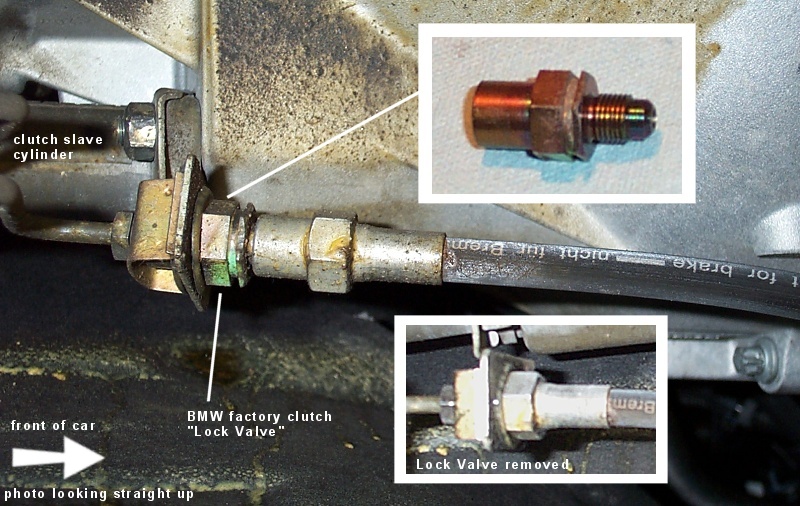|
|
| BMW E46 Clutch Hydraulic Lock Valve (CDV) - Removal |
|
|
|
|
|
| BMW E46 Clutch Hydraulic Lock Valve (CDV) - Removal |
|
|
 This is an example of the "Lock Valve" that BMW has seen fit to install into the clutch hydraulic
circuit of many of its newer model manual transmission cars. The lock valve has coloquially been named
the CDV, or Clutch Delay Valve, as it delays the engagement of the clutch relative to the rate at which the
driver releases the clutch pedal. This particular CDV was taken out of a
2001 E46 325iT (Touring, aka Sport-Wagon). It is quite likely that all the non-M E46 manual
transmission cars have a valve like this valve installed at the factory (it is also common on other model
BMW's such as the 5-series and Z-series cars). There is no clear consensus
on whether the valve was ever intentionally installed on the E46 M3.
This is an example of the "Lock Valve" that BMW has seen fit to install into the clutch hydraulic
circuit of many of its newer model manual transmission cars. The lock valve has coloquially been named
the CDV, or Clutch Delay Valve, as it delays the engagement of the clutch relative to the rate at which the
driver releases the clutch pedal. This particular CDV was taken out of a
2001 E46 325iT (Touring, aka Sport-Wagon). It is quite likely that all the non-M E46 manual
transmission cars have a valve like this valve installed at the factory (it is also common on other model
BMW's such as the 5-series and Z-series cars). There is no clear consensus
on whether the valve was ever intentionally installed on the E46 M3.
|
|
The 12/03 BMW ETK appears to show that the lock valve is not installed on any E46 M3 or 330Ci models. Yet there are some reports from folks with early model E46 M3's who did have the lock valve installed. So perhaps the only way to know for sure if you have one is to get under the car and have a look. Note that those folks who have removed the CDV from their E46 M3's report the design to be different than what I removed from my 325i. The E46 M3 CDV reportedly has a moving disc inside the body, which would appear to cause the hydraulic restriction to vary depending on whether the clutch was being disengaged or engaged (clutch pedal pushed in or released). The part number for the 325i CDV which I removed from my 2001 Touring is 21 52 6 755 892 (this number is stamped on the part). I am not sure if this is the same part number as for the CDV found on the E46 M3, as the ETK does not show it at all on that model. So what is this lock valve and what does it do? |

|
|
The BMW "Lock Valve" (aka CDV) is a simple brass fitting with a small constriction which fits into the clutch hydraulic actuation circuit (at least this is so for the 325i unit, CDV's from other model BMW's appear to be slightly more sophisticated). The constriction limits the rate of fluid flow when the clutch is either engaged or disengaged. The presumed intent of adding this constriction in the clutch hydraulic circuit is to prevent sudden engagement of the clutch in order to reduce driveline shock-loading. In other words, "side-stepping" the clutch becomes impossible. The diameter of the 325i CDV constriction is 1.5mm where the rest of the clutch hydraulic lines have an ID of roughly 3.5mm. What really limits fluid flow is cross-sectional area, and in this case the lock valve reduces the area by 82% - a substantial constriction. "So what?" - one might ask. BMW designed the car and the valve, what's the problem? Well the problem is that the lock valve greatly reduces the ability of the driver to execute fast and smooth shifts. In fact, the valve almost guarantees that fast shifts will be accompanied with a fair amount of clutch slip. Furthermore, the valve acts as a "damper" to clutch motion, even during normal everyday driving. Removal of the lock valve provides a noticeable improvement in clutch feel and sensitivity. Bottom line: removing the lock valve makes the car a lot more fun to drive, and reduces that rubbery disconnected feeling from the clutch pedal. In case you want to determine if your car has a CDV, and if it does and you want to remove it, then the following picture will help. The lock valve is installed towards the end of the clutch hydraulic circuit, right before the clutch slave cylinder on the side of the bell-housing. There is a rubber hose extending down from the firewall (beneath where the driver's feet are). This hose carries hydraulic fluid from the clutch master cylinder located on the pedal cluster, down to the slave cylinder. Where the rubber line transitions to the metal line leading into the slave cylinder, you will find the "Lock Valve". The picture below will help in identification. The valve is easy to remove - you'll need two 17mm open end wrenches to do this. Once the valve is out the end of the rubber hose (which has an identical shape) simply takes its place. Some fluid will drip out so you will want to bleed the clutch circuit when you're done. That's it. Less than a 30 minute job. My only regret? That I drove the car for over two years before removing the valve! |

|
|